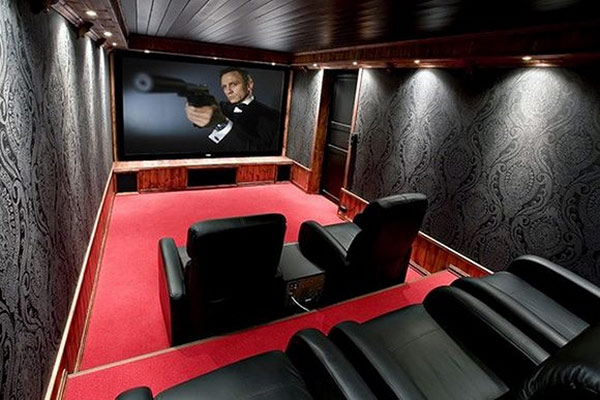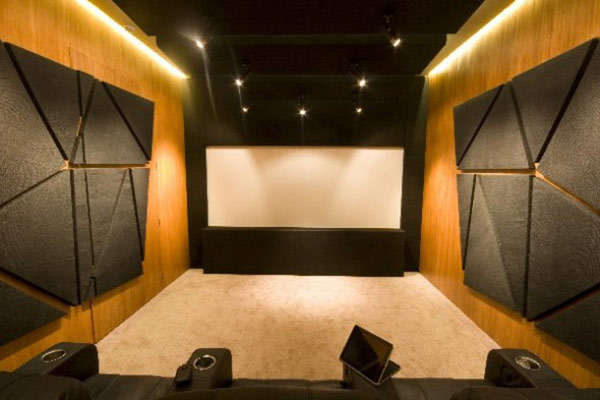Having a home theatre in your house can, or cannot be a luxury parade – all you need is a big enough flat screen, and a room that would accommodate, not only a small gathering, but a few essentials that define the very characteristics of a theatre experience. The number of people you entertain do not matter, if the ambience is not correct – if it doesn’t hit that cinematic sweet spot, so specified of a big screen Cineplex. So here are 10 easy steps to decorate your home theatre, and make it a better conversance in a home-base setting.
1. Big Screen – Small Screen
The creative juxtaposition between the movie screens is what differentiates the home theatre system from the cinema. So when you’re designing a home theatre make sure that the screen you choose is, if not big enough, then prominent enough in its entirety that it alludes to the senses. The best way to do that, would be to make the screen a feature element of the room. There are several ways to do that:
- Use the long established ‘curtains-up’ and ‘curtains-down’ method – where the integrity of the screen, and the overall experience can be quintessential in the drama of the curtains.
- Another method, would be to make the backdrop the darkest shade your color palate might allow. That would ensure that the quality of the motion picture, with lights on, or off, would make the screen be a feature element of that specific wall.
2. The Seating Discrepancies
There are two ways that you could affix your seating in a home theatre – either use couches, or make use of the ‘lazy’ chair. The choice, not only depends on your taste and aesthetics, but also on the availability of space in the room. If you want to design a theatre for a large number of people, the couch would be the best way to go, but if you’re designing for luxury, with an adequate amount of space, then the ‘lazy’ chair, would be the best choice.
3. Make a feature out of your collection
The cinematic experience would be nothing without the motion picture itself, and the best way to feature that experience, would be to show case your collection. The best placement for such a feature would be the back wall, closest to the entrance, so that you may make the selection and show off your collection as soon as you enter the home theatre itself.
4. Side walls
The most distinctive feature, that could alleviate the aura of an actual Cineplex are the side walls – for they are the ones that define the ambience of the home theatre. In actuality, they should be dark in color – a nice mahogany or espresso, in finish – with an automated system of lighting, so that it may not overbear the actual experience of the home theatre system. The dark color would solidify the aura of a cinema, while the automated lighting would highlight that characterization of that experience.
5. Snacks
Another highlight of the cinematic experience is eating snacks – and to incorporate that in the home theatre, one would have to make room for a snack bar, that is adequately sizeable, and automated in lighting. The automated lighting would ensure that the actual lighting doesn’t hinder the viewing of the movie, itself, while highlighting the area you would need to go to, when and if, interval hits.
6. Lighting
Lighting is an important aspect of any theatre, and even more so, for a home theatre. It has to be designed and allocated in such a way, that it does not take from the cinematic experience, while at the same time, caters to the aura, and the overall ambience of the theatre. For that to happen, you can make use of rope lights, and small minimum wattage, beam bulbs. The rope lights create an understated study in lighting, while the beam bulbs highlight the focal areas, i.e., the snack bar, the movie collection, the screen, etc.
7. Acoustics
Acoustics are a major part of any cinema – and to ensure that the sound does not deviate or morph, it has become a static field in cinematic interior design. The most efficient design strategy to compliment that, would be to use leather bounding on the side walls – so that it absorbs the stray vocals, while amplifying the actual sound effects.
8. The Omnimax Experience
The Omnimax experience, in its entirety could not be achieved in a simple home-theatre. But taking from that concept itself, it can become a highlight design feature for the ceiling of a home theatre. What you can incorporate from that concept, would be an overall stagnant, but majestic featurette that would become the highlight of your ceiling, before, during, and after intervals.
9. Throw Pillows
Another strategy for design based intervention would be the use of throw pillows – not only would they highlight a lazy sort of leisure, but also a stylistic pragmatism that would characterize the overall integrity and aesthetic of the home theatre deign.
10. Extra Activities
Aside from that, if your theatre is adequately sizeable, then there are a few extra activities that you could incorporate into the interior design – an example of which, would be a pool table, so that if you want, you can indulge in other activities during the viewing of the motion picture.


